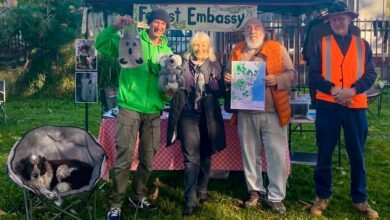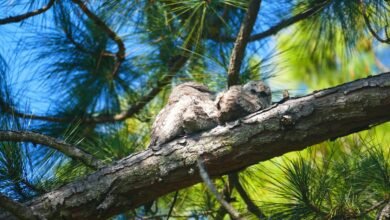Forest Ecology Alliance (FEA) & Citizen Science
May 15

Forest Ecology Alliance (FEA) is attempting to save NSW State Forests from indiscriminate logging regimes, currently focusing on Newry State Forest on the NSW Mid North Coast under threat of imminent logging. Newry SF is Koala habitat and Koalas are present. It is also an important corridor linking coastal forest up to Point Lookout on the Great Dividing Range.
FEA welcomed Cate Faehrmann, Greens MLC MP to see Newry State Forest for herself. She was presented with a report of scientifically driven arguments for saving Newry SF and offering important information of what is at stake for the future of this forest, its habitats, fauna and flora. Gumbaynggirr elders, the local indigenous custodians are clear that logging is not appropriate, as there are significant cultural sites present.

The 30-page report (May 2021) covers the survey work, including soil samples, identifying threatened species, Koala food trees, old growth trees and more. FEA members Mary-Lou Lewis and Sally Cavanagh collected many soil samples from various sites due to be logged using Emerson Aggregate test guidelines. Their analysis led to the recommendation that: ‘It is our opinion that logging should not be conducted at this site. The steep slopes and narrow ridge top identified for proposed work are at the top of catchments running North, East and West. Any logging works would result in releasing large amounts of sediment downstream due to the unstable subsoil.’ The report also notes that using the timber for biofuel is a criminal waste of forests and is a polluting process.

The report included an essay I wrote for it:
The many values of Newry State Forest
We encourage everyone to visit Newry State Forest and other remnant old growth forests. Being in these ancient forest beats visiting an art gallery. It’s much more than simply looking at static trees or views. You become immersed in dynamic environments with birds, insects, trees, flowers. Walking in a forest energises all the senses that come into play, smell, hearing, touch, feeling.
To enter a wood is to pass into a different world in which we ourselves are transformed. Roger Deakin[1]
Newry SF offers a generous invitation to experience, examine and explore. You will find ancient trees up to 8 metres in circumference, trees that are homes and habitats, sheltering insects, animals and birds, feeding them, and supporting orchids and epiphytes. Old trees are important, it can take a hundred years to form hollows suitable for various species of glider, kingfishers and parrots.
You have stood there for centuries
arms gaunt reaching for the sky
your roots in cadence
with the heart beat of the soil. Jack Davis[2]
Newry SF is also home to Koalas. The NSW population has declined by 71% since the catastrophic bushfires and were already in serious decline by an estimated 30% since 1990.[3] Their greatest threat is habitat loss. Save this habitat and you save other threatened species, such as, the Spotted-tailed Quoll, Powerful Owl, Sooty Owl and Yellow-bellied Glider, as well as threatened flora. Fossil remains of Koala-like animals date back 25 million years. Conserving biodiversity maintains the healthy ecosystems that we rely on. And allowing species’ extinction after millions of years of an extraordinary, shared evolutionary process which produced Homo sapiens I think is criminal.
Logging is a declining industry, and Newry SF is unfit for logging due to its vertiginous slopes and erodible soil. There is huge economic value in saving old growth forest and not only for the maintenance of ecosystem processes. A landmark study reports that through tourism the proposed Great Koala National Park (incorporating Newry SF) would deliver a significant lift in jobs and a projected additional regional economic output of $1.2 billion over the next 15 years, plus $1.7 billion in biodiversity value.[4]
And what of ethics? This is not simply the Mid-North Coast of New South Wales, this is Gumbaynggirr Country (Capital C). The forest is culturally significant with a precious indigenous history and a precious present with stories and song. We need to hear Ngaya yaam daalgiyay (I am singing) again.
Such a marvel is this fifteen-billion-year process. We now need to tell this story, meditate on it, and listen to it as it is told by every breeze that blows, by every cloud in the sky, by every mountain and river and woodland, and by the song of every cricket. We have lost contact with our story. Thomas Berry [5]
Eucalypt forests evolved from rainforest habitat, adapting to nutrient-poor soils and increasing aridity. Their story is uniquely Australian as is the Koala. Millions once lived in this country yet now the NSW Koala population is listed as ‘Vulnerable’. And what of their future/our future? What will this region look like in 50 years’ time? 500 years’ time? As it is, in just over 200 years, ‘Just 50% of Australia’s forests and bushlands remain intact compared with pre-European arrival. The other 50% has been either permanently destroyed and replaced with another land use or is classed as degraded forests and bushlands.’[6]
The epic of Gilgamesh (circa 2,700BCE) describes vast tracts of cedar forests which the Sumerian king Gilgamesh cut down, earning the gods’ wrath. By 2,100 BCE, tree clearance had led to soil erosion and salt build-up which devastated agriculture. One cuneiform reported, ‘the earth turned white’. That ‘civilization’ (now southern Iraq) had to move – what do we learn?
This is not our world with trees in it. It’s a world of trees, where humans have just arrived. Richard Powers [7]
We – you – me – everyone – are at a fundamental crossroads. Our way of life for 99% of human existence, that of the hunter–gatherer, has finished, and the world population has tipped from rural to urban. Our agrarian revolution has rapidly evolved into industrial production and factory farming. Together with proliferating new technologies, they alter people. No longer connected to the natural world and processes changes how we think, feel and behave.
These ongoing transformations drive global warming, biodiversity and habitat loss, the poisoning of land, waterways and seas and destruction of eco-processes and systems. Our physical health and wellness are dependant on the health of our soils, forests, waterways, our atmosphere, and of other life forms that share this planet.
As the pioneer of nature conservation Aldo Leopold argued, unless people are moved to value the natural world not just in terms of economics, but also in terms of ethics and aesthetics, they have far less reason to preserve it or to engage with it. Once you get know the wonders of Newry State Forest, you may well want to help defend it. Leopold asked us to: ‘Examine each question in terms of what is ethically and aesthetically right.’ [8] Answer – Save the forest.
I love it tree because he love me too.
He watching me same as you
Tree he working with your body, my body,
he working with us. Bill Neidjie[9]
[1] Roger Deakin, Wildwood A Journey Through Trees, Hamish Hamilton, 2007.
[2] Jack Davis, Nyoongah, WA. ‘Forest Giant’, Little Book of Trees, Comp. Joanna Karmel, National Library of Australia. 2010.
[3] Biolink, report for WWF-Australia, ‘Quantifying the impacts of bushfire on populations of wild koalas (Phascolarctos cinereus): insights from the 2019/20 fire season.’ July 2020.
[4] Roberta Ryan, University of Newcastle, ‘Great Koala National Park Economic Impact Analysis and Environmental Benefit Assessment, 2.2.2021. http://www.hrf.com.au/gknp
[5] Thomas Berry, ‘The Ecozoic Era: Eleventh Annual E. F. Schumacher Lectures,’ October 1991, http://www.schumachersociety.org/lec-tber.html. [DL 7.2.2000]
[6] ‘10 facts about deforestation in Australia’, Wilderness Society, 25.2.2021.
[7] Richard Powers, The Overstory, W. W. Norton & Company, 2018
[8] Aldo Leopold, A Sand County Almanac, OUP, 1968, p262.
[9] Bill Neidjie, Gaagudju Elder, ‘Kakadu Man’, https://www.majala.com.au/news/kakadu-man, 1989. The last surviving speaker of the Gaagudju language.



